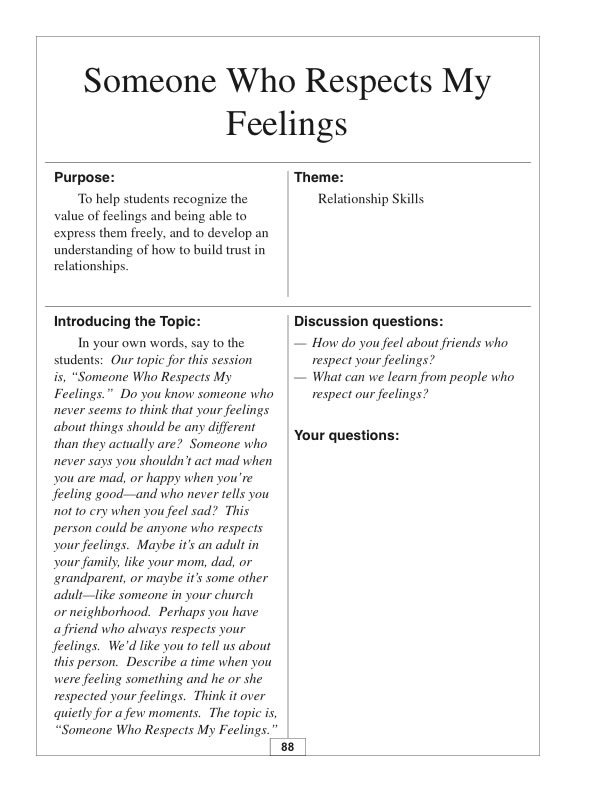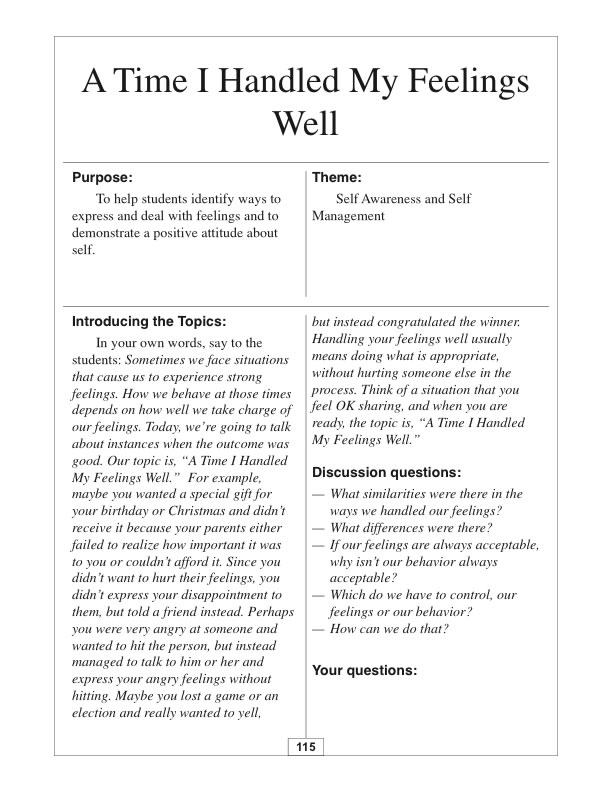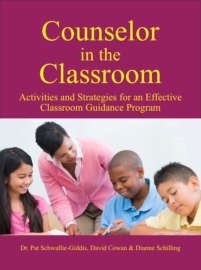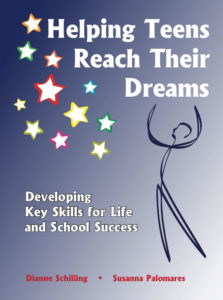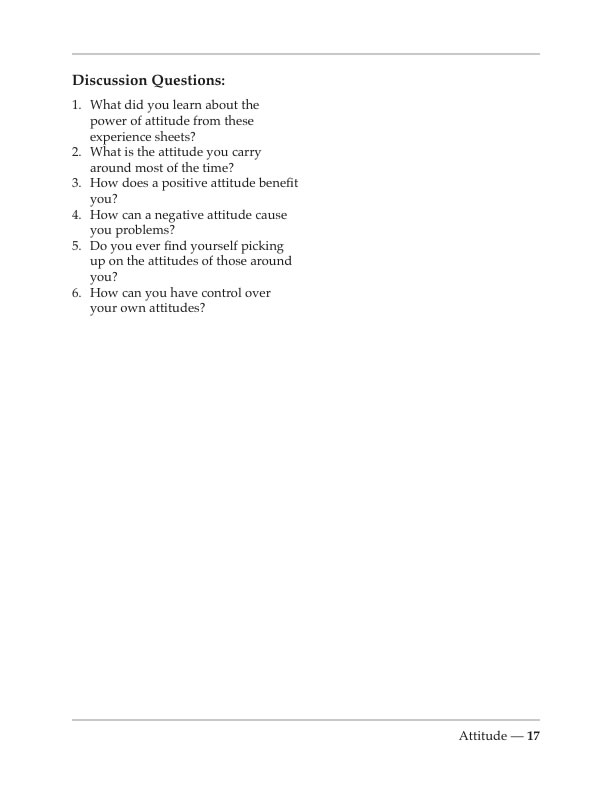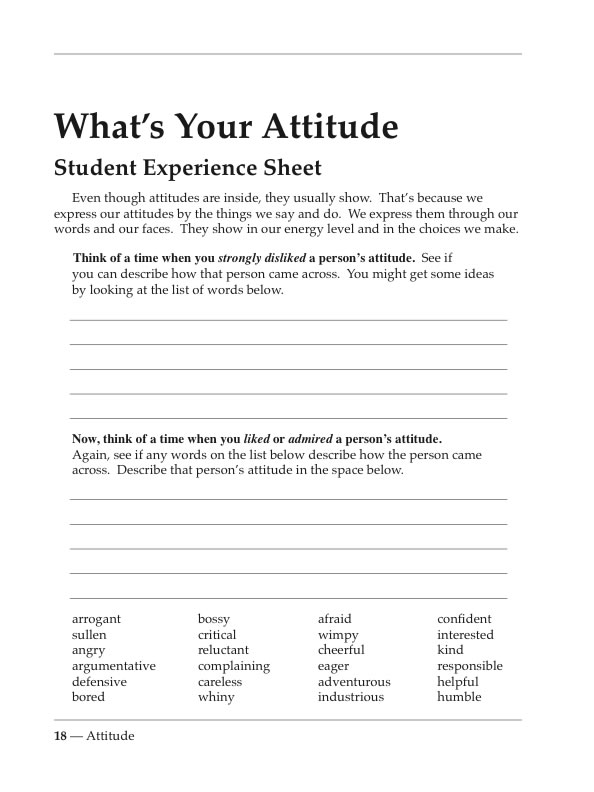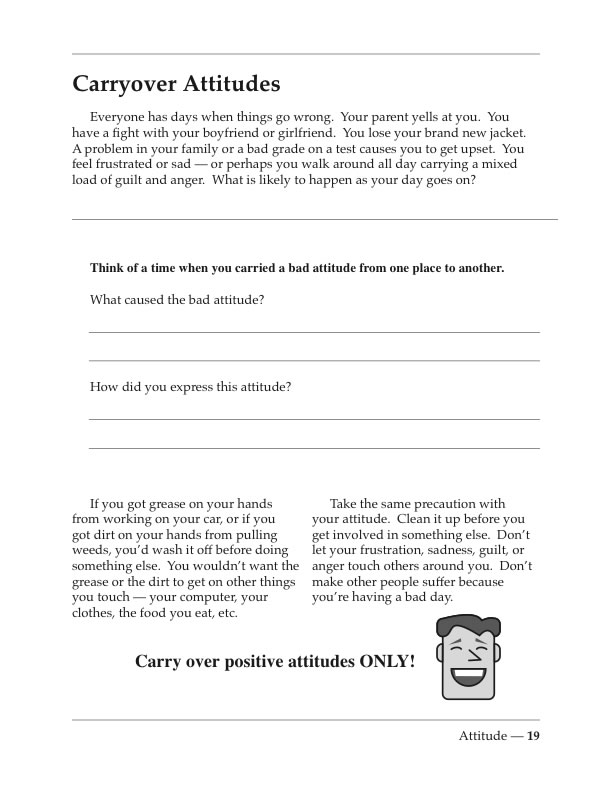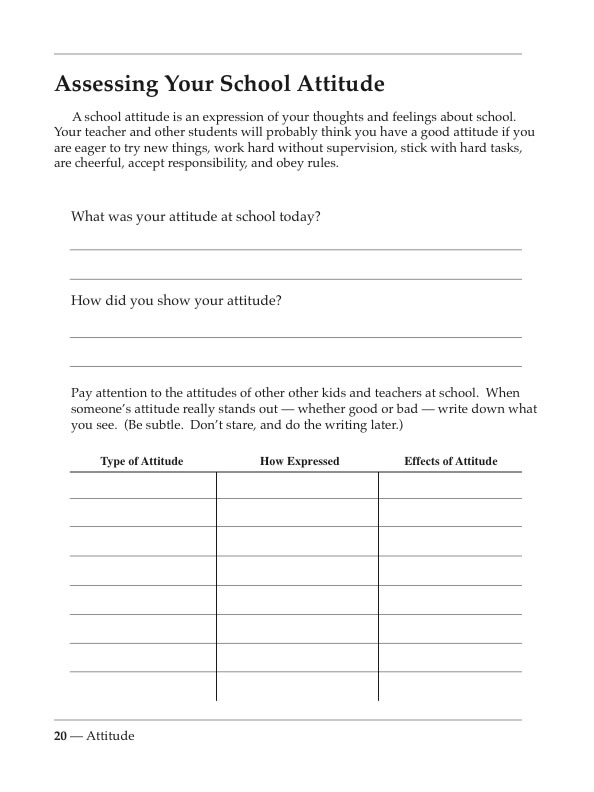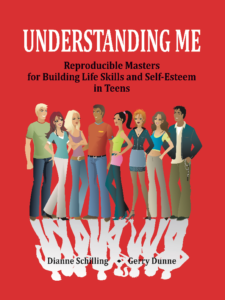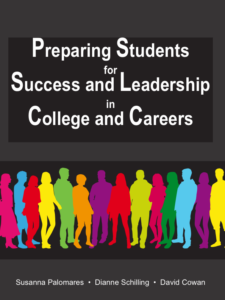Recognizing the Importance of Emotions and Feelings
Try this little exercise. On a blank sheet of paper draw a line down the center. Label the left side Feelings, and the right side Actions. On the left side, write a list of as many of the feelings you can remember that you’ve had today. Leave a few spaces between the words. You may think of a feeling you had in traffic getting to school, or a response to a student, etc. Take only a minute to write this list of feeling words.
Now move to the action side. Pick out one positive feeling you wrote, and opposite it in the action column, write what you remember you did in response to that feeling. You may have laughed, said thanks, etc.
Next, pick one feeling that was not pleasant and write down what you did.
Now, pick out the feeling that made you most uncomfortable and write down what you did.
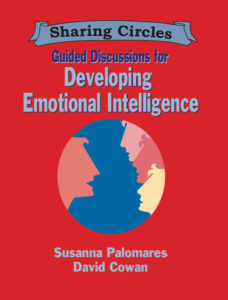
Can you see how absolutely our actions are connected to our feelings? We all respond to our feelings, not in the exact same way, but we all do respond. Our feelings flow from our emotions. All people have the same emotions. Things like love, hate, fear, etc. The feelings people have as they experience these emotions can vary as can their behaviors in response to these feelings. Emotions generate our feelings, and our feelings are messages that tell us that we are experiencing an emotional event. It is what we do in response to these feeling messages that is a measure of our emotional intelligence.
The Impact of Emotional Intelligence
Because of their connection to behavior, emotions impact every area of life: health, learning, achievement, and relationships.
Managing feelings well and recognizing and responding effectively to the feelings of others enables students to lead happy and productive lives and to master habits of mind that contribute to personal and career success. We all, parents and educators, must nurture emotional intelligence in the same caring way we nurture IQ.
Think for a minute about the implications of this to what students need to learn – to what we need to teach. What a gift we give to students when we help them learn to channel their feelings into positive behaviors and developing self control.
Here Are Your Sharing Circle Lessons
Today’s Sharing Circle topics come from the K- 12 book, Guided Discussions for Developing Emotional Intelligence. Sharing Circles are a superb tool for helping students to identify, understand, and manage their feelings, and this book has over 100 Sharing Circle lessons. The topics are, Someone Who Respects My Feelings and A Time I Handled My Feelings Well.
 Here’s Your Monday Morning Sharing Circle. Enjoy!
Here’s Your Monday Morning Sharing Circle. Enjoy!
Do you want more information?
• Leading a Sharing Circle
• Sharing Circle Rules
• Books and Resources
• Free Activities
• Subscribe
Go here:
Here’s How It’s Done
Gather everyone into a circle. Explain the rules for sharing, and get agreement from everyone that they will follow the rules.
Sharing Circle Rules:
- Everyone gets a turn to share, including the leader.
- You can skip your turn if you wish.
- Listen to the person who is sharing.
- There are no interruptions, probing, put-downs, or gossip.
- Share the time equally.
After everyone has shared, who wants to share, ask the discussion questions.
You can check the book out HERE.
Just click HERE to open a fully reproducible PDF of this activity and experience sheet…
If you like our blog resources and would like to receive them regularly, please subscribe here or on our website at www.InnerchoicePublishing.com
If you are already a subscriber, I hope you find this activity valuable. Help us grow our blog by sharing these activities and encouraging others to join. Thank you.
Thanks so much for reading!
Susanna
[New Post] Helping Students Set Goals in the New Year
I have always believed that setting goals is one of the keys to success in life. Successful people have a habit of setting clear goals concerning things that they want to accomplish. Even students in the elementary grades should be introduced to the basics of goal setting. Goal setting isn’t rocket science. It’s really pretty simple and helping students understand that every time they say something like “I want to get an A on the test” or “I have to finish my homework so I can go to the game tonight” They are setting goals. The trick is to set deliberate goals in areas that count and to write goals in a way that will give them the greatest possibility of achievement. Since we’re beginning a new year what better time than now to work on goal setting.
Here’s a free Activity and Experience Sheet
Use this goal setting activity to inspire your students. Also, take advantage of the accompanying Experience Sheet to drive home the learnings. This activity comes from Counselor in the Classroom, a learning guide for the elementary grades. Enjoy!
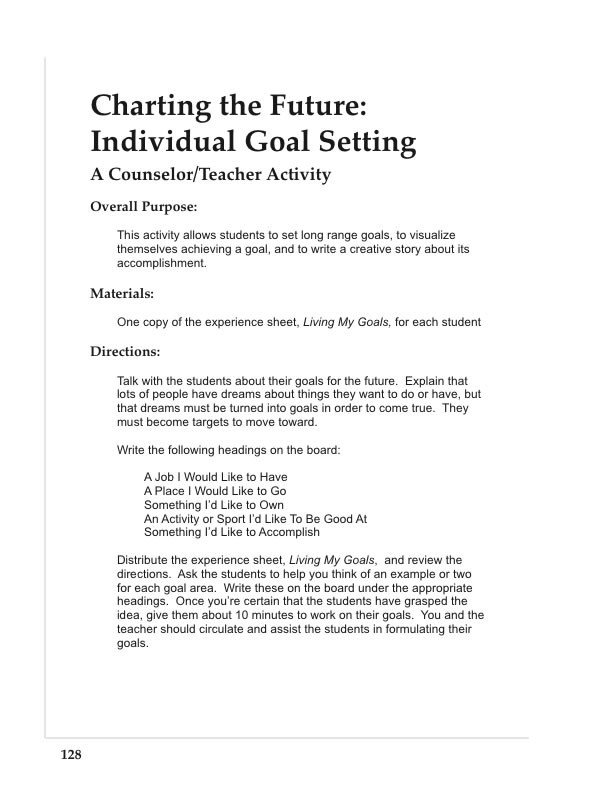
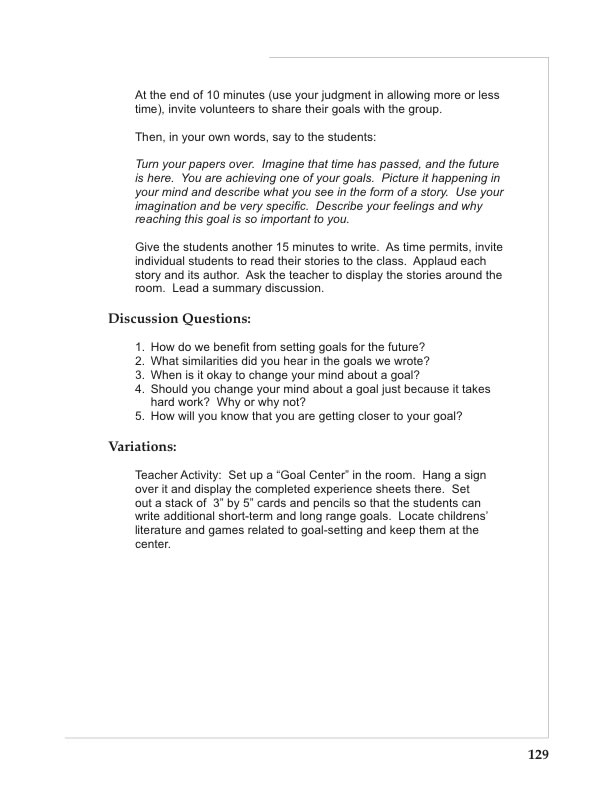
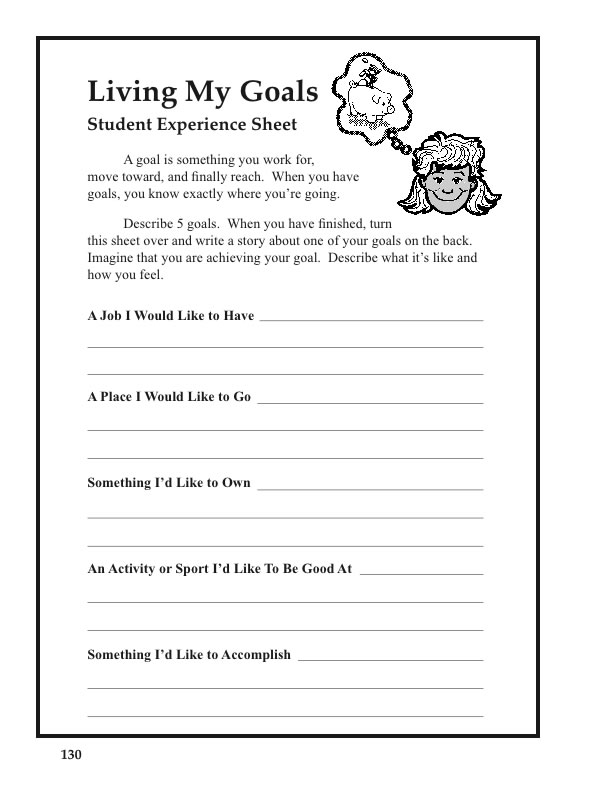
You can check the book out HERE.
Just click HERE to open a fully reproducible PDF of this activity and experience sheet…
If you like our blog resources and would like to receive them regularly, please subscribe here or on our website at www.InnerchoicePublishing.com
If you are already a subscriber, I hope you find this activity valuable. Help us grow our blog by sharing these activities and encouraging others to join. Thank you.
Thanks so much for reading!
Susanna
Helping Students Develop Positive Attitudes
It’s All About Attitude
It has been said that life is forty percent what we make it, and sixty percent how we take it. Whatever the ratio, the point is clear that attitude is a defining lens. We always have a choice about how we respond to events in our lives.
To recognize the benefits of developing positive, responsible attitudes, young people must first grow in self-awareness. They must learn to understand feelings and their relationship to thoughts, and they must understand that their own feelings are normal, predicable, and susceptible to control. Feelings convey messages about conditions and events going on in the environment, and provide important clues to the way the brain is processing information.
As William James said over one hundred years ago, “Human beings, by changing the inner attitudes of their minds can change the outer aspects of their lives.”
A Tool You Can Use
This week’s activity helps students learn about the power of their attitudes – how negative attitudes cause problems and how positive attitudes can be a benefit to all aspects of their lives. The activity, Developing a Positive Attitude, has two parts – a group discussion followed by an experience sheet.
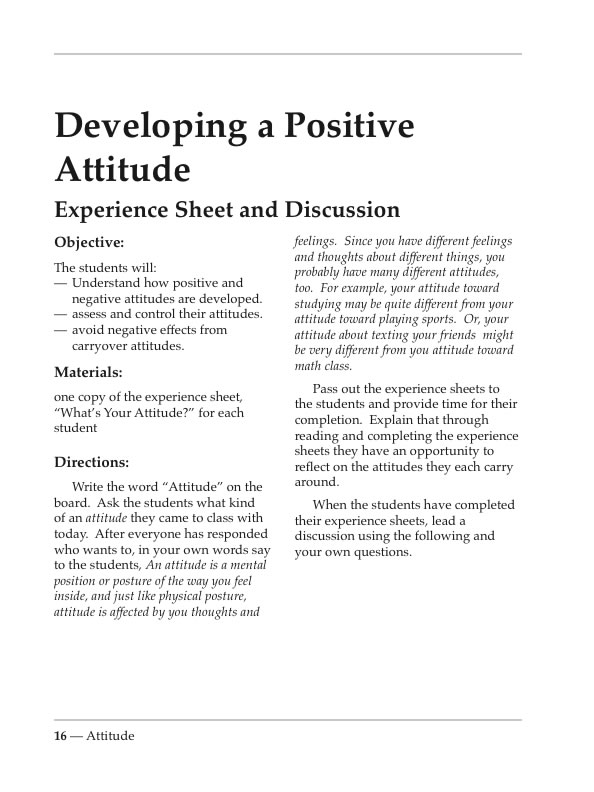
You can check the book out HERE.
Just click HERE to open a fully reproducible PDF of this activity and experience sheet…
If you like our blog resources and would like to receive them regularly, please subscribe here or on our website at www.InnerchoicePublishing.com
If you are already a subscriber, I hope you find this activity valuable. Help us grow our blog by sharing these activities and encouraging others to join. Thank you.
Thanks so much for reading!
Susanna
A Lifetime Skill – Handling Peer Pressure
In virtually every area of living life skills are needed. Along with math, science, technology, history and English, students also need to be taught how to manage themselves, their time and activities. They need to know how to get along with others and to formulate goals and communicate their needs in a pro-social manner. Too often these critical life skills are not addressed in a direct fashion but their acquisition is simply left to chance. Students often don’t learn effective ways to deal with life issues. They have ideas but can’t express them clearly. They get into conflicts they don’t know how to resolve. They have hopes and dreams but can only drift through life.
The Current Reality
Often it’s the lack of skills and awarenesses that prevent many from becoming fully capable, contributing, happy members of society. School is the ideal places to directly teach life skills, both for their impact on the future and because life skills ensure the effective application of academic skills today.
Here’s a Resource and How to Use It
Understanding Me develops, maintains, and enhances critical life skills. Among the life skills addressed in these activity sheets are:
• decision making
• goal setting
• communication
• conflict management
• learning
• leadership
• time management
• responsibility
• assertiveness
• career choic
• trust
• friendship
• culture
• justice
In addition to your own enabling behaviors and the cultivation of an affirming classroom or counseling environment, you can assure a positive impact on the social-emotional development of your students by infusing these activities into your regular curriculum or counseling efforts. They represent one of many possible approaches and can be enlisted as supplements to other strategies you are currently using.
A Complimentary Activity
UNDERSTANDING ME is packed with meaningful information for teens to learn new ideas, attitudes, behaviors, perspectives, and skills while promoting self-awareness and self-esteem. These flexible worksheets can be used by anyone working with teens – teachers, counselors, youth group and after-school leaders, home-schoolers, and parents.
Today’s selected student activity is entitled Pressure!. What is Peer Pressure and what do you do with it?
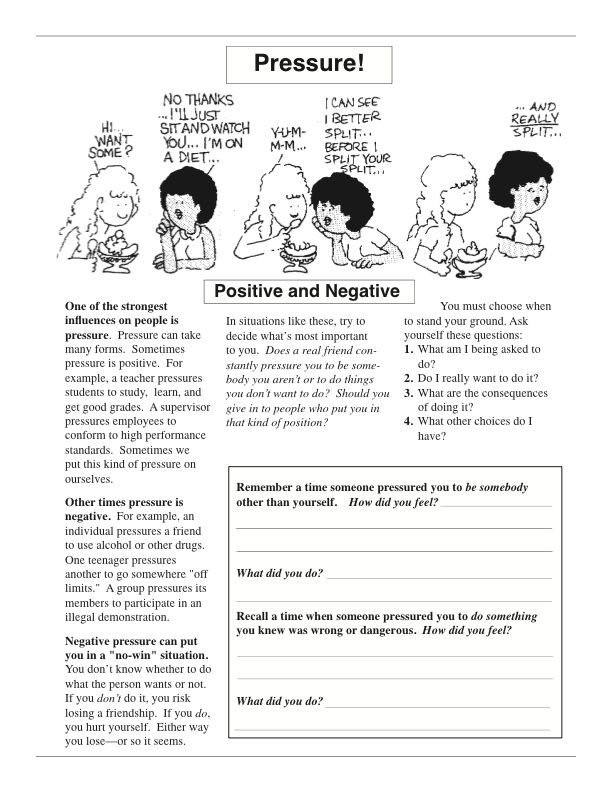
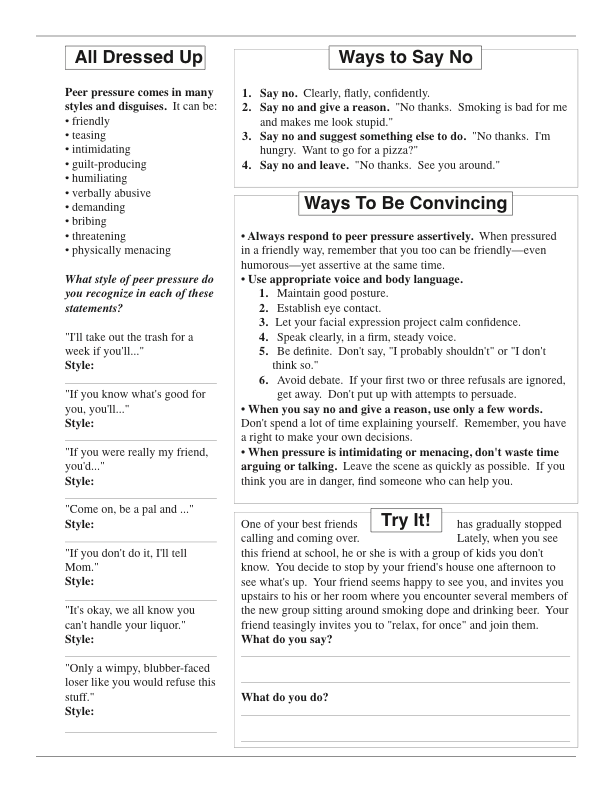
Use this activity now, and purchase the book to have a whole library of instantly usable social skills skills activities with which to engage your students.
You can check the book out HERE, and you can open a reproducible PDF of your student activity HERE.
If you like our blog resources and would like to receive them regularly, please subscribe here or on our website at www.InnerchoicePublishing.com
Thanks so much for reading!
Dianne Schilling & Gerry Dunne (Authors)
We All Need To Be Getting Along!
What does it take for people to get along? What is required for individuals and groups from diverse backgrounds to willingly seek common ground while respecting and proudly maintaining the sundry paths that brought them to the places they share?
The Reality
Our multicultural society is made up almost exclusively of immigrants and the descendents of immigrants, many of whom arrived on these shores seeking religious tolerance and freedom from oppression. What ethics must we nourish in our children, what skills do our youth need to learn in order to appreciate the brilliant kaleidoscope of colors and cultures they have inherited? How can we get them to honor, enjoy, and protect what increasing numbers would shatter and separate into little piles of hues and textures with jagged, hostile edges?
A Place to Begin
We can start by recognizing that a school is a community and the classroom a smaller community, and that whatever happens here not only goes home, but to the theater, the mall, the library, the park, the athletic event, and the religious service. Children must grasp that in order for any of us to truly enjoy and benefit from the amenities and opportunities that are available in the community, in order for any of us to feel entirely safe and secure, in order for any of us to expect optimal conditions for learning and growth, we must ensure that those same benefits, securities, and conditions are available to all of us. In short, we must learn to get along. We don’t always have to agree. We can expect to have different ideas, different values, and different goals, but we must learn to respect one another’s rights, to work and play cooperatively, to resolve conflicts, and to take responsibility for our own behaviors and the effects those have on others and on the community as a whole.
What It Really Takes
Merely admonishing students to be “good citizens” is not enough. Most are very familiar with the label and can readily parrot all the implied expectations. For students to get along in the deeper sense characterized by true interdependence, they have to develop self-awareness; undertake responsibility for their actions; accept and appreciate differences in others; listen with empathy and understanding; communicate their thoughts and feelings accurately and assertively; include others in their activities; be open to divergent styles and points of view; work together to solve problems and complete projects; and peacefully resolve any conflicts they experience along the way. What’s more, they have to be conscious that they are doing these things, and be able to verbalize the reasons and benefits. To develop competency in these areas involves the acquisition of specific skills, along with growing awareness and open discussion concerning the process. This in turn requires not just explanation, but modeling, plenty of practice or behavioral rehearsal, and ongoing dialogue.
A Complimentary Activity
The activities in GETTING ALONG – Social Skills Activities for Middle and High School Students are designed to introduce students to these skills in a deliberate, enjoyable fashion and, in the process, elevate their awareness of the responsibility that each has to make the classroom and/or school a cooperative environment where everyone is included, where people experience true interdependence, and where dissent and conflict are never fearsome or ugly but, rather, natural and productive.
Today’s selected activity, Promoting Inclusion, comes from the unit “INCLUDING OTHERS”.
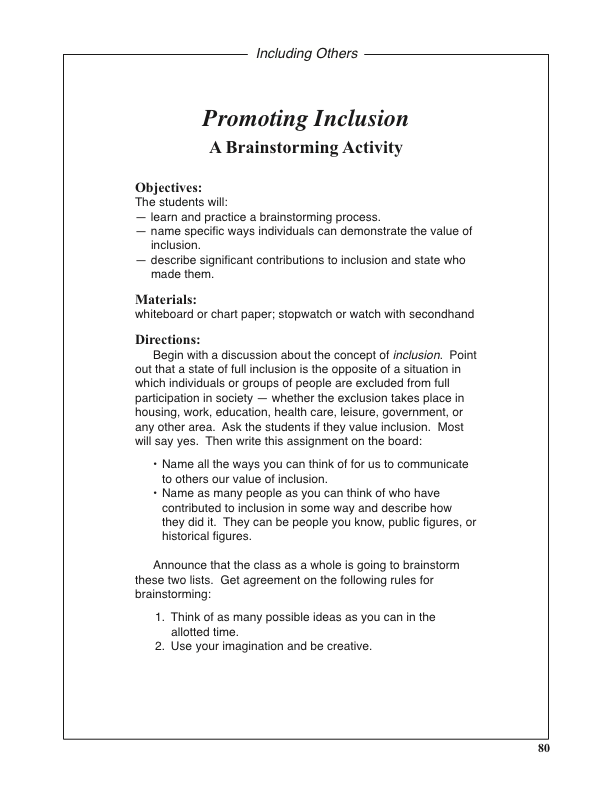
 Use this activity now, and purchase the book to have a whole library of instantly usable social skills skills activities with which to engage your students.
Use this activity now, and purchase the book to have a whole library of instantly usable social skills skills activities with which to engage your students.
You can check the book out HERE, and you can open a reproducible PDF of your student activity HERE.
If you like our blog resources and would like to receive them regularly, please subscribe here or on our website at www.InnerchoicePublishing.com
Thanks so much for reading!
Dianne Schilling (Author)
A Sharing Circle About DEALING WITH DIFFERENCES
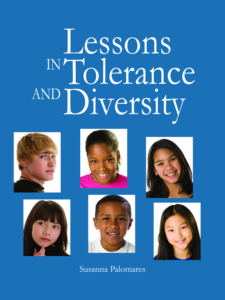
This Sharing Circle topic comes from the grades 2-12 resource book, Lessons in Tolerance and Diversity. It lets your students explore the differences between themselves and their friends. The topic helps your students understand that we all differ from one another and that these differences are what really are at the root of all our relationships but, importantly, from the foundations for our friendships. The topic for this Sharing Circle is, Lessons in Tolerance and Diversity…
 Here’s Your Monday Morning Sharing Circle.
Here’s Your Monday Morning Sharing Circle.
Enjoy!
I Have a Friend Who Is Different From Me
Purpose:
This circle asks students to identify specific differences between themselves and their friends, and fosters respect for differences in race, culture, lifestyle and ability.
Introduce the Topic:
Today we are going to talk about friends who are different from us and what we like about them. The topic for this session is, “I Have a Friend Who Is Different From Me.”
We are all alike in many ways, but we are also different. Today, I want you to think about a friend who is different from you in at least one major way, and tell us why you like this person so much. Perhaps your friend is of a different race, or has a much larger family, or is many years older than you. Does your friend speak a different language or eats a different way than you do? Does your friend have a disability that causes his or her lifestyle to be different from yours? Maybe your friend celebrates birthdays differently than you do, or has different holidays. Tell us what you enjoy about this person. Does your friend listen to you and share things with you? Does he or she invite you to go places? Do you have something in common like a love of sports, music, or computers? Think about it for a few minutes. The topic is, “I Have a Friend Who Is Different From Me.”
Discussion Questions:
1. What are some of the ways we differ from our friends?
2. How are you enriched by the differences between you and your friend?
3. What causes people to dislike other people because of things like race or religion?
4. What would our lives be like if we could only make friends with people who are just like we are?
Do you want more information?
• Leading a Sharing Circle • Sharing Circle Rules
• Books and Resources • Free Activities • Subscribe
Here’s How It’s Done
Gather everyone into a circle.
Explain the rules for sharing, and get agreement from everyone that they will follow the rules.
Sharing Circle Rules:
• Everyone gets a turn to share, including the leader.
• You can skip your turn if you wish.
• Listen to the person who is sharing.
• There are no interruptions, probing, put-downs, or gossip.
• Share the time equally.
After everyone has shared, who wants to share, ask the discussion questions.
Get more in-depth information here.
Just click HERE to open a fully reproducible PDF of this Sharing Circle activity…
If you like our blog resources and would like to receive them regularly, please subscribe here or on our website at www.InnerchoicePublishing.com
Thanks so much for reading!
Susanna
PS: If a friend forwarded this to you, you can just sign up to get your own weekly Innerchoice Counselor Activity Blog.
Preparing Your Students to Be College and Career Ready
What it Takes
What does it take for young people to be college and career ready? Today’s students will need to succeed and lead in a highly competitive global economy, a knowledge-based society and a hyper-connected digital age. It’s no longer enough to just be trained in technical skills. Today’s workers need interpersonal and relationship skills. They need to know how to communicate and collaborate. In short they must develop a full spectrum of life skills which provides the foundation for success in college, career, at home and in the community.
Here’s the Resource
Preparing Students For Success and Leadership in College and Careers provides a comprehensive collection of over 140 effective activities for you to engage your students in the development of the skills employers are looking for and is required for success in college. With this curriculum guide you’ll have at your finger tips meaningful activities that help your students to make effective decisions, solve problems, act responsibly, set goals, learn to work as part of a team, and develop effective communication and conversational abilities. LEARN MORE HERE
By developing these skills in your students now you’ll be promoting their college and career success.
A Complimentary Activity
Here is a goal setting activity and reproducible student activity sheet from Preparing Students for Success and Leadership in College and Careers. Use this activity now, and purchase the book to have a whole library of instantly usable activities to engage your students in preparing for their lifetime of success.
You can check the book out HERE, and you can open a reproducible PDF of your student experience sheet HERE.
If you like our blog resources and would like to receive them regularly, please subscribe here or on our website at www.InnerchoicePublishing.com
Thanks so much for reading!
Susanna
PS: If a friend forwarded this to you, you can just sign up to get your own weekly Innerchoice Counselor Activity Blog.

